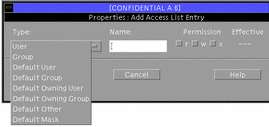To Add an ACL Entry
-
Display the File Manager Properties dialog box as described in "To View a File or Folder's ACL Entries".
-
Click the Add button at the right of the ACL area (see Figure 5-7) to display the Add dialog box.
The File Manager Add Access List Entry dialog box with the Type menu displayed is shown below. Note that for folders all menu items are available. For files, only the User and Group menu items are active.
Figure 5-8 File Manager Add ACL Dialog Box

-
Specify the type of ACL entry.
The ACL types enabled in the options menu depend on whether you selected a file or folder. Only the User and Group items are available for files. All entries are enabled for folders. If you need to review the ACL types, see Table 5-1.
In addition, if you select one of the default entries, a message will be displayed at the bottom of the dialog box as a reminder that the default owning user, default owning group, default other, and default mask will be added with their permissions enabled accordingly.
-
Specify the name if enabled.
When you select User, Group, Default User, or Default Group, you must enter a name (or ID).
If you select Default Owning User, Default Owning Group, Default Other, or Default Mask, the name field is disabled, since it is not necessary.
-
Click the permissions you wish to enable (or disable).
A check mark means that the permission is enabled. If you select a permission that will be overridden by the mask, a warning will be displayed in the message display area at the bottom of the dialog box, along with a beep. The effective permissions column will indicate the difference. You are nonetheless allowed to make the entry and it will take effect if the mask is modified to permit it later.
-
Click Add in the dialog box.
This adds the entry, causing it (and any related default entries) to be displayed in the Access Control List area. If you do not like the setting in the default permission settings, you can change them (see "To Change an ACL Entry").
-
To specify the target item(s) for the permissions or ACL entries that you specified, select the appropriate target in the Apply Changes To option menu at the bottom of the window.
You can select the current file, all files in the parent folder, or all files in the parent folder and its subfolders.
-
Click OK or Apply to save the ACL entries (and any permissions you have changed).
- © 2010, Oracle Corporation and/or its affiliates
